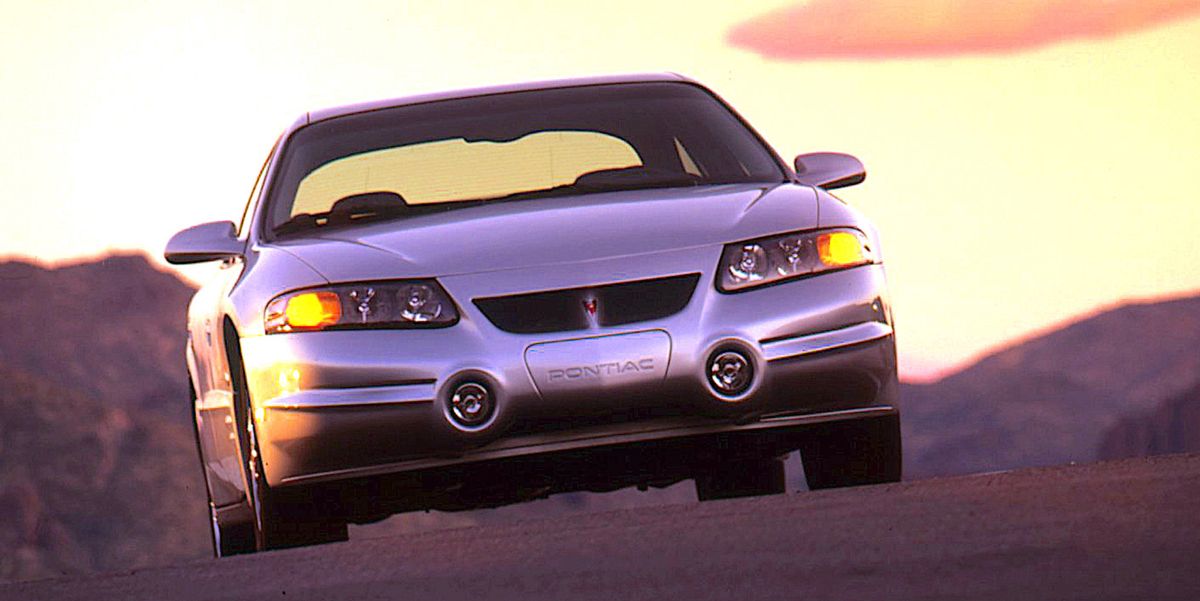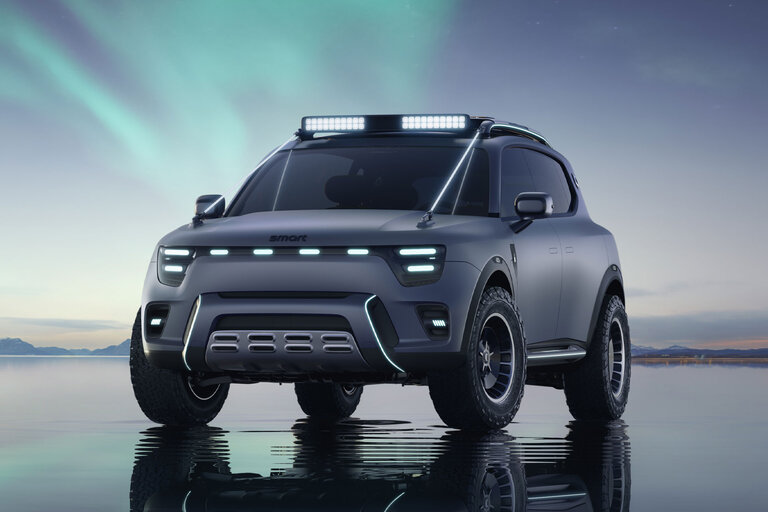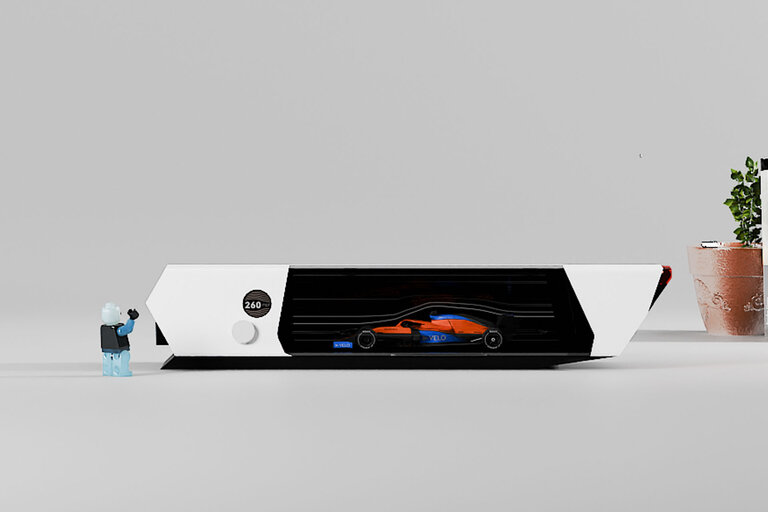
From the March 1999 issue of Car and Driver.
Our last official visit with a Pontiac Bonneville wasn’t memorable. It was grim, even. It was part of the massive 10-car “Salt-of-the-Earth Sedans” comparison test in June 1998. The Bonneville took on such flashy newcomers as the Oldsmobile Intrigue, the Dodge Intrepid, the Honda Accord, the Toyota Camry, and the eventual winner, the Volkswagen Passat.
The ’98 Bonneville SE found few friends among the test drivers. Criticisms like “mushy-feeling” and “wallows around” and “spongy” peppered the brief six-paragraph account, which ended with this: “In its seventh year, the Bonneville is the oldest car in this group by three years, and it shows.”
The Bonneville finished 10th of 10 cars. A subsequent drive of a ’99 Bonneville showed no improvement over the 1998 model—it was, after all, simply one year older.
The people at Pontiac took this criticism to heart. Frankly, they weren’t surprised. They were well aware that a new Bonneville was on the way. And when they offered us an exclusive drive in the 2000 Bonneville, we took that as an indication they had confidence in the new car. That confidence was well founded.
The current Bonneville—spiritually, anyway—traces it roots to the new-for-1987 model. On a platform shared with the Buick LeSabre and Oldsmobile Delta 88, the 1987 Bonneville SE was powered by a 150-horsepower version of the 3.8-liter pushrod V-6. It was a single-mindedly sporty sedan, clearly targeting the Europeans and, in some aspects, hitting the mark: The interior was “the closet thing to a BMW’s this side of the Black Forest,” we wrote, proclaiming the Bonneville as one of our 10Best cars for 1987. The following year, a sportier SSE model was introduced, setting the tone for the top-of-the-line Bonneville that continues today.
The Bonneville was redesigned for 1992, and again, we singled out the performance model as our favorite. The SSEi kept the 3.8-liter V-6, but a supercharger bumped horsepower from the standard 170 to 205. The package was completed with boy-racer pseudo-ground effects, Z-rated tires, electronic ride control, and dual airbags—the 1992 Bonneville SSEi was the first GM car to have both driver and passenger airbags.
Not a lot has happened since. The 3.8-liter perseveres—horsepower is up to 205 on the standard engine and is 240 for the supercharged model, but other changes to the Bonneville since 1992 have been so minor and evolutionary that newer models from the competition promptly passed it by.
Enter, then, the 2000 Bonneville. It’s based on the same platform as the new Buick LeSabre (C/D, January 1999)—which will be introduced before the 2000 Bonneville’s October on-sale date—and the Oldsmobile Aurora, which will be introduced after that. The Bonneville is, GM tells us, by far the most performance-minded application of this G-platform.
The Bonneville’s wheelbase is considerably longer—112.2 inches, up from 110.8. The track was widened by two inches. The body is slightly longer overall, and it’s 0.3 inch taller. The wheels were moved out to the corners of the car, contributing to a more aggressive appearance. The rake of the windshield is a swoopy 64 degrees, compared with the 1999 model’s almost upright 58 degrees.
There’s a bit of the tapered Coke-bottle shape to the sides, shared with the Grand Prix, giving the profile a sense of family within the Pontiac brand that’s long been absent from the Bonneville.
There will be three models: the base SE, destined largely for fleet sales; the more upmarket SLE; and the SSEi, the top of the line. Pontiac has departed somewhat from the previous marketing strategy that offered the Bonneville SSE to customers who wanted the sporty looks but the base engine; those who wanted more horsepower got the supercharger and SSEi badging. Now, the sporty look comes only on the SSEi, and the supercharger is strictly an option. That could confuse current Bonneville owners—the car does, after all, enjoy a surprisingly healthy 35-percent customer repurchase rate—as well as insurance companies, which may assume that because it’s an SSEi it must be supercharged.
The base SE, which will likely account for about 70 percent of the 80,000 Bonnevilles that Pontiac hopes to sell in 2000 (up about 20,000 from 1999), is nonetheless a handsome, well-appointed car. Power comes from a 205-hp, 3.8-liter V-6. Sixteen-inch tires and wheels are standard, as are driving lights, a good AM/FM/cassette stereo with a compact-disc player, steering-wheel-mounted audio controls, a tire-pressure monitor, front and side airbags, and four-wheel disc brakes, a first for the Bonneville. That car should start at about $24,000—a very competitive price.
The supercharged SSEi we drove is at the other end of the spectrum—loaded, it should list for about $34,000, a modest increase over a comparably equipped 1999 model. (We expect the supercharger option to cost about $1200.)
And “loaded” it was, lacking only heated seats and a sunroof from being a check-every-box example. Carryover parts from the current car are few—even the venerable 3.8-liter V-6 has undergone some fairly extensive changes, including a new harmonic balancer, power-steering pump, alternator, transmission-oil pump, and induction and air-cleaner system. The Bonneville’s battery was moved to beneath the rear seat, which improves battery life (a more controlled temperature, less exposure to the elements), gets weight off the nose of the car, and allows for better underhood packaging. There is also a clearly marked junction box underhood for jumper-cable hookup.
The Bonneville shares quite a few parts with the Cadillac Seville, especially in the suspension, which has struts up front and semi-trailing arms in the rear. The mounts and bushings are tuned differently on each of the Bonneville models, with the SSEi getting the most aggressive settings, as well as different valving for the struts, a 30-millimeter hollow anti-roll bar up front (larger than on the SE), and the addition of a 20-millimeter anti-roll bar in the rear (which the SE lacks altogether). The 17-inch tires and wheels on the upscale Bonnevilles allow for slightly bigger brakes. The top speed is governed at 130 mph and limited by the H rating of the Goodyear radials.
Inside, the current Bonneville’s busy dash and controls have been refined and much improved. The SSEi carries over the helpful head-up display (HUD), which can show speed, turn-signal operation, and radio frequency if desired. That—coupled with the audio controls mounted on the fat, leather-covered steering wheel—means there is little reason for the driver’s eyes to leave the road, a much-underrated safety feature. You can extinguish the HUD altogether or dim it to the point that it is readable but never intrusive. Unfortunately, it—like the rest of the instruments—is illuminated with Pontiac’s garish trademark orange-red light, which looks increasingly dated.
The leather-covered front seats are comfortable and multi-adjustable, but they lack side support. The front belts are seat-mounted, a vast improvement over the current car. The rear seats are more than adequate for a six-footer, and ingress and egress are painless. The 150-watt Delco/Bose eight-speaker stereo is as good as any on the market; our car had a compact-disc player in the dash, in addition to a 12-disc changer mounted in the trunk.
Pontiac has, as before, packed plenty of bells and whistles into the Bonneville SSEi. If it can be accomplished electronically—be it a small travel computer, speed-compensated radio volume, or heated mirrors—it’s likely part of the package. There are three power outlets—one by the ashtray, one in the rear of the console for back-seat passengers, and one in the roof, although that one disappears if the optional sunroof is ordered. Rear seats have thoughtful tethers for child seats built into the package shelf. In the trunk, there’s an emergency kit with a rain suit, a first-aid kit, gloves, a light, a snow scraper, and an air hose connected to a small compressor.
On the road, it’s immediately apparent that this is a new, improved car. That 3.8-liter pushrod V-6 may be a veteran, but it’s smooth and torquey, and when it’s supercharged, it’s quick. Pontiac says the 0-to-60-mph time should be 7.1 seconds, confirmed by an impromptu run with a stopwatch. Throttle tip-in is excellent, and on mountain roads in Arizona, the four-speed automatic transmission shifted up and down at all the right times. Previous experience with the magnetic variable-assist power steering has drawn mixed reviews, but in the SSEi, it felt linear and natural. The brakes are firm and progressive—again, a departure from the mushy feel of the current car—and there was little nosedive during panic stops. The exhaust note is pleasant—the SSEi has two mufflers, fed through one catalytic converter.
Pontiac has adapted most of Cadillac’s StabiliTrak system, leaving out the pavement-texture compensator, and borrowed Cadillac’s old name: Integrated Chassis Control System (ICCS). Yaw sensors, wheel sensors, a lateral accelerometer, and a steering-angle sensor feed information to the traction-control system that can, among other things, help steer the car during skids using the brakes. The ICCS is seamless, even during spirited driving.
Like the 1987 Bonneville, the 2000 model is theoretically targeted at the Europeans, such as the BMW 5-series and the Audi A6. More realistically, the direct competition is the Chrysler 300M. (When Ford dropped the Taurus SHO, it pretty much abandoned the $30,000 sports-sedan market.)
We like the 300M—a 10Best car for 1999—and we like the 2000 Bonneville SSEi. We’re certain that’s a comparison test Pontiac awaits with anticipation.
Specifications
Specifications
2000 Pontiac Bonneville SSEi
Vehicle Type: front-engine, front-wheel-drive, 5-passenger, 4-door sedan
PRICE
Base (est.): $24,000–$31000
ENGINE
pushrod 12-valve 3.8-liter V-6, 205 hp, 230 lb-ft; supercharged pushrod 12-valve 3.8-liter V-6, 240 hp, 280 lb-ft
TRANSMISSION
4-speed automatic
DIMENSIONS
Wheelbase: 112.2 in
Length: 202.6 in
Width: 73.8 in
Height: 56.0 in
Curb Weight (C/D est): 3750–3950 lb
MANUFACTURER’S PERFORMANCE RATINGS (SUPERCHARGED)
60 mph: 7.1 sec
Top Speed (governor limited): 130 mph
EPA FUEL ECONOMY
City/Highway: 18/27 mpg
#Pontiac #Bonneville #SSEi #Supercharges #Sport #Sedan
Source link





